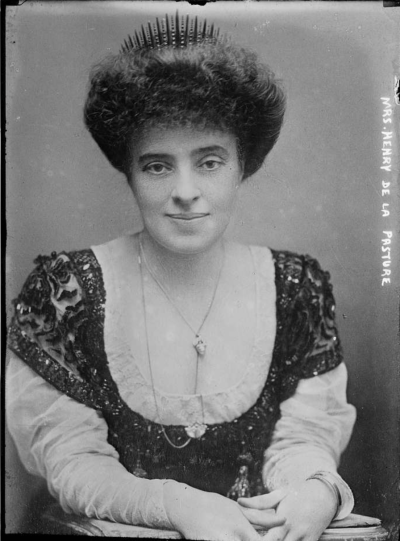
We confess that occasionally, it is a photograph that inspires a post. This image intrigued us for the lady’s flouncy finery juxtaposed with her Great Danes’ no-nonsense visage.

Photo of Mrs. Henry de la Pasture from Picryl, public domain media. There are no known restrictions on this image which is in the public domain.
That the photo was taken in another time (1907) is obvious by the fine lady’s dress, and from the severe ear crops of the Great Danes with her. This is not a post about cropping, nor do we welcome comment on it, but a brief explanation may be helpful at this point.
Great Danes were used to hunt wild boars in Germany during the 17th century, a dangerous endeavor for a dog. Armed with sharp teeth and lethal tusks, a boar was quite capable tearing off a dog’s ear – and worse. Cropping part of the ear reduced the area that boars could damage during hunting. Many owners also believed that dogs with erect ears were less prone to ear infections. The practical nature of cropping became a style, and as evidenced in the image, cropping was more severe than it is now.
As for the lady, she is Mrs Henry de la Pasture, an English novelist and playwright. The daughter of Edward Bonham,HM Consul in Calais, and great-granddaughter of Sir Samuel Bonham, a colonial administrator who was created baronet on his retirement, Mrs. de la Pasture wrote many novels between 1900 and 1918, including The Unlucky Family, The Little Squire, Adam Grigson, Catharine of Calais, The Man from America, Master Christopher and Erica. Her plays included Peter’s Mother, The Lonely Millionaires, Her Grace the Reformer and Deborah of Tod’s. A sample of her work appears below, the opening paragraph of Peter’s Mother published in 1905.
Above Youlestone village, overlooking the valley and the river, and the square-towered church, stood Barracombe House, backed by Barracombe Woods, and owned by Sir Timothy Crewys, of Barracombe. From the terrace before his windows Sir Timothy could take a bird’s-eye view of his own property, up the river and down the river; while he also had the felicity of beholding the estate of his most important neighbour, Colonel Hewel, of Hewelscourt, mapped out before his eyes, as plainly visible in detail as land on the opposite side of a narrow valley must always be. He cast no envious glances at his neighbour’s property. The Youle was a boundary which none could dispute, and which could only be conveniently crossed by the ferry, for the nearest bridge was seven miles distant, at Brawnton, the old post-town.
Because Peter’s Mother was deemed culturally important, it has been made available to read for free here.
Mrs. de la Pasture had two children from her first marriage before she was widowed, and one of them, Edmée became a well-known novelist in her own right.
We found nothing written about de la Pasture’s Great Danes, but as the image serves as a historical marker for the breed, we thought to share it here.
Top image is from WikiMedia Commons and is in the public domain in the United States.
